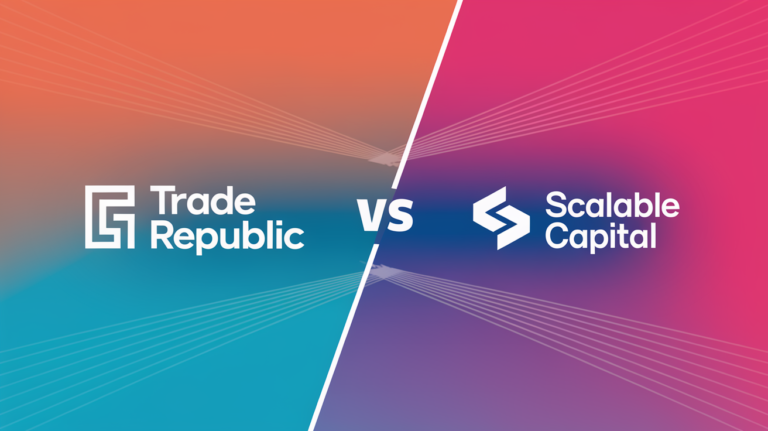Discover Trade Republic order types explained simply for beginners. Learn how to use market, limit, and stop orders to trade smarter in 2025! Also read Trade Republic Registration Documents: Complete 2025 Guide and Trade Republic Customer Support: Ways to Get Fast Help (2025).
Introduction
When I first started using Trade Republic, I remember staring at the order types like they were written in another language. What’s a market order? How’s it different from a limit order? And don’t even get me started on stop orders! If you’ve felt this way too, trust me—you’re not alone.
Understanding these order types isn’t just about learning the lingo; it’s about gaining the confidence to make smarter trades. Whether you’re looking for quick executions or careful price control, knowing which order type to use can make a world of difference.
In this guide, I’ll break down the Trade Republic order types—market, limit, stop, and stop-limit—in plain, beginner-friendly terms. By the end, you’ll know exactly how to choose the right one for your trading goals. Ready to take the guesswork out of trading? Let’s dive in!
Takeaway Box:
| Order Type | Best For | Key Benefit |
| Market Order | Quick trades in liquid markets | Immediate execution |
| Limit Order | Price control for volatile assets | No overpaying or underselling |
| Stop Order | Managing risks in volatile conditions | Automated trade execution |
| Stop-Limit Order | Precision in controlling execution prices | Combines stop and limit benefits |
What Are Trade Republic Order Types?
Trade Republic offers four main order types: market orders, limit orders, stop orders, and stop-limit orders. Market orders execute trades immediately at the best available price, while limit orders allow you to set a specific price for buying or selling. Stop orders activate once a predetermined price is reached, and stop-limit orders combine price control with trigger conditions. Each order type caters to different trading goals, from speed to price precision and risk management.
Understanding Market Orders
Market orders are the most straightforward type of order you can place on Trade Republic. When you execute a market order, you’re instructing the platform to buy or sell a specific stock or security immediately at the best available market price. This means execution speed is prioritized over price control.
How Do Market Orders Work?
When you place a market order, it looks for the nearest available price in the market. This works exceptionally well for highly liquid stocks, where there’s always a buyer or seller available.
However, in volatile markets, prices can fluctuate quickly, and the final price you pay or receive might differ slightly from what you expected. This difference is known as slippage.
When to Use Market Orders
Market orders are ideal in these scenarios:
- High Liquidity: When trading stocks with large daily volumes.
- Urgency: When speed is more important than the exact price.
- Long-Term Investments: For investors who are less concerned about small price differences.
| Scenario | Should You Use a Market Order? |
| Highly liquid stocks | Yes |
| Volatile market conditions | No |
| Small trade quantities | Yes |
| Thinly traded stocks | No |
Pros and Cons of Market Orders
| Pros | Cons |
| Immediate execution | Price uncertainty due to market fluctuations |
| Simple and beginner-friendly | Slippage can impact expected price |
| Works well in stable or liquid markets | Not suitable for illiquid or volatile stocks |
Practical Tip: If you’re trading a stock during a major news event or earnings release, avoid market orders. Prices can change rapidly, and you may end up paying significantly more or selling for less than anticipated.
Mastering Limit Orders
A limit order allows you to control the price at which you buy or sell a stock. Unlike market orders, which prioritize speed, limit orders focus on price control. You set a maximum price you’re willing to pay (for a buy order) or a minimum price you’re willing to accept (for a sell order).
How Do Limit Orders Work?
Limit orders remain open until the market price reaches your specified limit. For example, if you want to buy a stock priced at €50 but only if it drops to €45, you can place a limit order at €45.
- If the market hits €45 or lower, your order will execute.
- If it doesn’t, your order remains pending or gets canceled after a set period.
When to Use Limit Orders
Limit orders are best suited for:
- Volatile stocks: Control your entry or exit price.
- Targeted trades: Ensure you only trade at favorable prices.
- Less liquid stocks: Avoid wide bid-ask spreads.
| Scenario | Should You Use a Limit Order? |
| Highly liquid stocks | No, market orders are better |
| Stocks with wide bid-ask spreads | Yes |
| Specific price targets | Yes |
Pros and Cons of Limit Orders
| Pros | Cons |
| Full control over trade price | No guarantee of execution |
| Ideal for volatile or illiquid markets | May miss opportunities if prices change |
| Useful for setting clear trading goals | Requires patience |
Exploring Stop Orders
A stop order activates once a predetermined price, known as the stop price, is reached. It can be used to protect against losses or capitalize on momentum.
Types of Stop Orders
- Buy Stop Orders: Triggered when the price rises above a certain level. Useful for entering trades during upward trends.
- Sell Stop Orders: Activated when the price falls below a set level. Ideal for limiting potential losses.
How Do Stop Orders Work?
Stop orders become market orders once the stop price is hit. For example:
- If you own a stock at €100 and want to sell if it drops below €90, you place a stop order at €90.
- If the price hits €90, your order is executed at the next available price, which might be slightly higher or lower.
| Stop Order Example | Action Triggered |
| Stock price falls to €90 | Sell at market price |
| Stock price rises above €110 | Buy at market price |
Pros and Cons of Stop Orders
| Pros | Cons |
| Automates risk management | No price guarantee once triggered |
| Protects profits and limits losses | Prone to slippage in volatile markets |
| Useful in volatile or fast-moving markets | May execute at unfavorable prices |
The Power of Stop-Limit Orders
Stop-limit orders combine the features of stop orders and limit orders, giving you control over both price and execution conditions.
How Do Stop-Limit Orders Work?
A stop-limit order is activated once the stop price is reached, but it will only execute within the limits you specify. For example:
- Stop price: €90
- Limit price: €85
- If the stock price drops to €90, the order activates but will only execute if it stays above €85.
When to Use Stop-Limit Orders
- In volatile markets: Protect against rapid price swings.
- For precision trades: Ensure you only trade within acceptable price ranges.
- To combine risk management and control: Ideal for advanced strategies.
| Scenario | Should You Use a Stop-Limit Order? |
| Need precise price control | Yes |
| Risk of rapid price changes | Yes |
| Low liquidity | No, execution may fail |
Pros and Cons of Stop-Limit Orders
| Pros | Cons |
| Combines control and risk management | Execution not guaranteed within limits |
| Protects against extreme price swings | May miss opportunities in fast-moving markets |
| Useful for advanced trading strategies | More complex to set up |
Choosing the Right Order Type
Selecting the right order type on Trade Republic depends on your trading goals, risk tolerance, and the specific market conditions you’re dealing with. Each order type has its strengths and weaknesses, and knowing when to use each one can make a significant difference in your trading success.
Factors to Consider When Choosing an Order Type
- Urgency vs. Price Control
- Market Orders: Perfect for immediate execution when speed is a priority.
- Limit Orders: Best when controlling the price is more critical than quick execution.
- Market Conditions
- Stable Markets: Market orders are more effective due to minimal price fluctuations.
- Volatile Markets: Limit orders and stop-limit orders help manage risk.
- Trading Strategy
- Short-Term Trading: Market orders can help you react quickly to opportunities.
- Long-Term Investing: Limit orders ensure that you enter or exit at a favorable price.
- Liquidity of the Asset
- High Liquidity: Market orders work well for frequently traded assets.
- Low Liquidity: Limit orders prevent unfavorable pricing in thinly traded stocks.
Comparing Order Types
| Order Type | Best For | Pros | Cons |
| Market Order | Immediate trades | Fast execution | Price uncertainty during volatile markets |
| Limit Order | Price-sensitive trades | Control over trade price | No guarantee of execution |
| Stop Order | Risk management | Protects against significant losses | Price slippage risk |
| Stop-Limit Order | Precision risk management | Combines control and risk limitation | Complex setup and no guaranteed execution |
Matching Goals to Order Types
| Goal | Recommended Order Type |
| Quick entry or exit | Market Order |
| Controlling trade price | Limit Order |
| Protecting against losses | Stop Order |
| Combining price control with risk | Stop-Limit Order |
Practical Examples of Choosing an Order Type
- Scenario 1: Trading a High-Volume Stock
- You want to buy shares of a popular tech company quickly.
- Recommended Order: Market Order for immediate execution.
- Scenario 2: Setting a Target Price for Entry
- You’re interested in buying a stock currently priced at €100 but only if it drops to €95.
- Recommended Order: Limit Order with a price set at €95.
- Scenario 3: Minimizing Risk in a Volatile Market
- You want to sell your shares if they drop below €80 to avoid further losses.
- Recommended Order: Stop Order with a stop price of €80.
- Scenario 4: Combining Risk Management and Precision
- You want to sell your shares if they drop below €90 but only if the price stays above €85.
- Recommended Order: Stop-Limit Order with a stop price of €90 and a limit price of €85.
Choosing the right order type isn’t just about understanding how each one works—it’s about aligning them with your goals and the market environment. Take the time to evaluate your priorities, and don’t hesitate to experiment with small trades to get comfortable. Over time, this knowledge can transform your trading experience from confusing to empowering.
Pro Tips for Using Trade Republic’s Order Types Effectively
Mastering the use of Trade Republic’s order types isn’t just about knowing how they work—it’s about leveraging them strategically. By applying a few proven tips and techniques, you can optimize your trading experience and minimize risks.
Practical Strategies for Market Orders
- Use in High-Liquidity Markets
Market orders work best when trading highly liquid assets like major stocks or ETFs. Liquidity ensures minimal price fluctuations during execution, reducing the risk of slippage. - Avoid During Volatility
- Avoid market orders when the market is volatile, such as during major news events or earnings releases.
- Volatility can cause significant differences between the expected price and the execution price.
- Pair with Alerts
Set price alerts to monitor key levels and decide when to use market orders. This minimizes the chances of acting on impulse or missing important price movements.
Optimizing Limit Orders
- Set Realistic Prices
- Avoid setting a limit price too far from the current market price. Unrealistic limits may result in missed trades.
- Example: If a stock is trading at €50, setting a buy limit at €30 is unlikely to execute unless there’s a market crash.
- Monitor Expiration Settings
- Trade Republic allows you to set time limits for your orders (e.g., day orders or good-till-canceled orders). Choose the right expiration based on your strategy.
- Adjust Based on Market Trends
- Review and adjust your limit prices as the market evolves. Sticking to outdated limits can cause you to miss opportunities.
Risk Management with Stop Orders
- Avoid Setting Stops Too Tight
- Placing stop orders too close to the current price can trigger unnecessary trades due to minor market fluctuations.
- Tip: Use a wider stop for volatile stocks and a tighter stop for stable ones.
- Combine with Limit Orders
- Pair stop orders with limit orders to ensure better price control once the stop is triggered.
- Example: Use a stop-limit order instead of a simple stop order to avoid execution at unfavorable prices.
- Use Trailing Stops
- Trailing stop orders adjust the stop price as the market price moves in your favor. This helps lock in profits while allowing for potential upside gains.
Advanced Use of Stop-Limit Orders
- Define Both Stop and Limit Prices Clearly
- The stop price triggers the order, and the limit price defines the maximum or minimum you’re willing to accept.
- Ensure there’s enough gap between the stop and limit prices to account for market fluctuations.
- Test in Volatile Conditions
- Stop-limit orders are particularly useful in volatile markets where precise control is needed.
- Example: If a stock is trading at €100, you might set a stop price at €95 and a limit price at €90 to minimize losses.
- Use for Swing Trading
- Swing traders often use stop-limit orders to capitalize on short-term price movements while minimizing downside risk.
Quick Comparison of Pro Tips
| Order Type | Best Practices |
| Market Order | Use in liquid markets; avoid during high volatility. |
| Limit Order | Set realistic prices; adjust based on trends. |
| Stop Order | Avoid tight stops; pair with limits for better control. |
| Stop-Limit Order | Test in volatile markets; define stop and limit prices clearly. |
Whether you’re trading as a beginner or refining your strategies, applying these tips can help you use Trade Republic’s order types effectively. Start small, experiment with different approaches, and let your experience guide you. Over time, these practices will empower you to trade smarter and more confidently.
Conclusion
Understanding Trade Republic’s order types is a game-changer for any trader, especially if you’re just starting out. Each order type—market, limit, stop, and stop-limit—serves a unique purpose, whether it’s prioritizing speed, controlling price, or managing risks.
Here’s the key: don’t rush. Start small, test each order type, and observe how they perform in different market conditions. Over time, you’ll gain the confidence to make smarter decisions and adapt your strategies to your goals.
Remember, trading isn’t about perfection—it’s about learning, evolving, and staying disciplined. With the knowledge of these order types, you’re well on your way to mastering the Trade Republic platform and turning your trading goals into reality.
Final Tip: Always stay updated with market trends and news, as these can significantly impact your trading strategies and the effectiveness of each order type.
FAQs
What is the difference between a market order and a limit order?
Market orders execute trades immediately at the best available price, prioritizing speed over price control. Limit orders, on the other hand, allow you to specify the maximum price you’re willing to pay or the minimum price you’ll accept, ensuring price control but not guaranteed execution.
When should I use a stop order on Trade Republic?
Use stop orders when you want to protect against potential losses or lock in profits. For example, if you own a stock and don’t want to lose more than 10%, you can set a stop price 10% below the current price.
Can I cancel or modify an order on Trade Republic after placing it?
Yes, you can cancel or modify an order on Trade Republic, but only if it hasn’t been executed yet. Once an order is executed, it cannot be changed.
What happens if my limit order isn’t executed?
If the market price doesn’t reach your specified limit, the order will remain pending. Depending on the time validity setting, it will either expire at the end of the day or remain active until canceled (Good-Till-Canceled).
Are stop-limit orders better than regular stop orders?
Stop-limit orders provide more control as they only execute within a specified price range. However, they may not execute at all in fast-moving markets, whereas stop orders guarantee execution but at the next available price, which might not be ideal.



